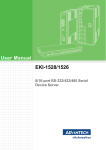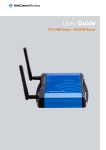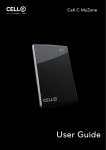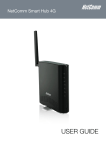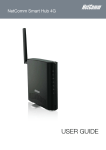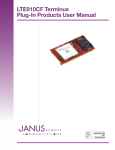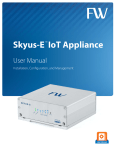Download CDM82x HTML Configuration Manual
Transcript
Call Direct Cellular Solutions CD Series Cellular Router User’s Manual Revision 1.57 March 2009 Call Direct Cellular Solutions 2003 Pty Ltd 1 This manual covers the following products:CDR-780seu CDM-882seu CDR-790seu Revision 1.57 March 2009 Call Direct Cellular Solutions 2003 Pty Ltd 2 Table of Contents Introduction ............................................................................................................................5 Cellular Router Overview.......................................................................................................5 2.1 Status Indicators.............................................................................................................7 3 What you will need to configure the Cellular Router ..............................................................8 4 Installing and unlocking the SIM card .................................................................................. 12 4.1 Inserting the SIM card ..................................................................................................12 4.2 Unlocking the SIM ........................................................................................................13 4.3 Enter PUK ....................................................................................................................17 4.4 The ‘Remember PIN’ feature ........................................................................................19 5 Locking to a specific band ................................................................................................... 20 6 How to Establish a Connection to the cellular network ........................................................ 22 6.1 Initiating a PPP Connection from the Cellular Router ...................................................23 To connect using a pre-configured profile .............................................................24 6.1.1 6.1.2 To connect using a user configured profile............................................................25 To confirm successful connection .........................................................................27 6.1.3 6.1.4 How to establish a Connection using the Cellular Router in PPPoE mode ...........28 7 Ethernet Related Commands .............................................................................................. 29 7.1 How to configure the Ethernet IP address ....................................................................29 7.2 How to configure DNS Masquerading ..........................................................................29 7.3 How to configure the DHCP Server ..............................................................................30 7.3.1 How to configure the DHCP relay agent................................................................31 7.3.2 How to configure static DHCP assignments ..........................................................32 7.4 How to configure your Device’s IP address manually (no DHCP) ................................33 8 Advanced Features ............................................................................................................. 34 8.1 How to configure the Periodic Ping Reset Monitor .......................................................34 8.2 How to configure a Periodic Reset Timer .....................................................................35 8.3 How to configure SNMP ...............................................................................................36 8.4 Remote Administration .................................................................................................37 8.5 NAT Configuration ........................................................................................................38 8.5.1 How to configure Port Forwarding .........................................................................39 8.6 How to configure dynamic DNS client ..........................................................................42 8.7 How to configure the Serial PAD (Packet Assembler and Disassembler) ....................43 9 Routing Features ................................................................................................................. 47 9.1 How to configure PPTP Client ......................................................................................47 9.2 Configuring Static Routes .............................................................................................49 9.3 How to Configure RIP ...................................................................................................52 9.4 How to configure VRRP................................................................................................53 10 Router Application and Configuration management ............................................................ 55 10.1 To save a copy of the routers configuration..................................................................55 10.2 To restore a copy of the routers configuration ..............................................................56 10.3 To restore the routers configuration to the factory defaults ..........................................56 1 2 Revision 1.57 March 2009 Call Direct Cellular Solutions 2003 Pty Ltd 3 10.4 To upgrade to a new router application version............................................................57 11 Troubleshooting ................................................................................................................... 59 11.1 Viewing the system log .................................................................................................59 11.2 Common problems and solutions. ................................................................................61 11.2.1 I cannot seem to access the web page interface ..................................................61 11.2.2 The Cellular Router was connected but cannot get back on .................................61 11.2.3 CDM Router is rebooting frequently ......................................................................61 11.2.4 CDM Router has connection but cannot access the internet.................................61 11.2.5 I cannot seem to get a wireless connection...........................................................62 11.2.6 I have set the Band but now it does not show the correct Frequency on the Home page and I cannot get a connection.....................................................................................62 11.2.7 The SIM status indicates that the SIM is “not installed or reboot required” on the Home page ..........................................................................................................................62 11.2.8 How can I reset the cellular router’s IP address to default ....................................63 11.2.9 I am having problems getting a PPTP connection. ................................................64 12 RS-232 Serial Port Integration Parameters ......................................................................... 65 13 RJ-45 Ethernet Port Integration Parameters ....................................................................... 66 14 Specifications ...................................................................................................................... 67 15 Download and Upload Speeds ............................................................................................ 68 16 Copyright Notice .................................................................................................................. 69 17 Limited Warranty ................................................................................................................. 70 Revision 1.57 March 2009 Call Direct Cellular Solutions 2003 Pty Ltd 4 1 Introduction Thank you for purchasing the Cellular Router from Call Direct Cellular Solutions. This manual illustrates how to set-up and configure your Cellular Router appropriate for your application. The Cellular Router is configured via a web browser. This manual will take you through the steps required to configure and use your unit correctly. Additionally the router may be configured via the units serial (V.24) port using “AT” (V.250) commands, this method of operation is further detailed in the document “CDSeriesCellularRoutersV250(AT)manual” 2 Cellular Router Overview This section describes the main physical features of the Cellular Router. Auxiliary RF antenna Primary RF antenna Serial (V.24) port Service Type LED DCD LED TX/RX LED Revision 1.57 March 2009 RSSI LED Call Direct Cellular Solutions 2003 Pty Ltd 5 USB Host Port Power Jack Ethernet Port SIM Card Slot Reset Button Revision 1.57 March 2009 Power LED Call Direct Cellular Solutions 2003 Pty Ltd 6 2.1 Status Indicators There are a total of five LED's on the Cellular Router: three green, one amber and one red. The green LED next to the DC power jack is the DC Power Indicator. The other four LED’s are grouped on the opposite end of the router, next to the RF antenna connector. Listed below are the specifications of the LED’s and their corresponding colours. POWER (Green) The green Power LED indicates correct power is applied to the DC power input jack. DCD (Amber) The amber Carrier Detect LED illuminates to indicate a Data connection. Tx Rx (Red) The red LED will light upon data being sent to or received from the cellular network. Service Type (Green) The green LED will illuminate when cellular network coverage is detected. Solid on : indicates UMTS/HSDPA available coverage Flashing : indicated EDGE available coverage Off : Indicates GSM/GPRS available coverage only. RSSI (Green) Of the three radio link status indicators, the green LED is used to show Received Signal Strength. There are three possible states that the RSSI LED can operate in, based upon signal level: Solid : Indicates the RSSI level is -90dbm, or greater (strong) Flashing once per second : Indicates the RSSI level is -110dbm and -90dbm, (medium) Off : Indicates the RSSI level is less than -110dbm (poor) Revision 1.57 March 2009 Call Direct Cellular Solutions 2003 Pty Ltd 7 3 What you will need to configure the Cellular Router You will need the following hardware components to set up the Cellular Router:Power Supply (8-28VDC) Ethernet cable Laptop or PC. Active Telecommunications carrier SIM card (USIM) NOTE – The Ethernet port on the Cellular Router is a DTE non-auto switch so you will need a crossover cable if connected directly to your PC. However, if there is a Hub/Switch connected between the Cellular Router and PC you will need to use a straight through cable. How to access the Cellular Router using the Web Browser Install the supplied antenna to the Cellular Router. This needs to be screwed to the RF Antenna connector. • For 850MHz networks use the black antenna provided • For 2100/1900MHz networks use the Gray antenna provided Connect power adapter to the mains and plug the output jack to the power jack of the Cellular Router. The green Power LED on the panel should illuminate. Connect an Ethernet crossover cable or straight through cable as appropriate between the Cellular Router’s Ethernet connector and the Ethernet Connector on your PC or switch. Configure your PC’s Ethernet interface to be dynamically assigned an IP address by doing the following: Revision 1.57 March 2009 Call Direct Cellular Solutions 2003 Pty Ltd 8 For Windows users: Follow the path Start -> Control Panel -> Network Connections. Right click Local Area Connection and select Properties to open the configuration dialogue box of Local Area Connection as below: Find and click Internet Protocol (TCP/IP) from the protocol list box and then click the Properties button The TCP/IP configuration window will pop up as illustrated below. Revision 1.57 March 2009 Call Direct Cellular Solutions 2003 Pty Ltd 9 Under General tab, select radio button Obtain an IP address automatically and Obtain DNS server address automatically. Then press OK button to close TCP/IP configuration window. Press the Close button to complete the computer preparation for the Cellular Router. Enter the address below in your web browser and connect . The username and password are defined below. Whenever you make changes please refresh your web pages to prevent errors due to caching of web pages. http://192.168.1.50 Username: admin Password: password Revision 1.57 March 2009 Call Direct Cellular Solutions 2003 Pty Ltd 10 Below illustrates the steps required to access the Cellular Router’s web browser: NOTE – If the Ethernet IP address of the Cellular Router needs to be changed then refer to the section: Configuring the Ethernet IP address. Revision 1.57 March 2009 Call Direct Cellular Solutions 2003 Pty Ltd 11 4 Installing and unlocking the SIM card 4.1 Inserting the SIM card First make sure the SIM card in inserted correctly. You insert the SIM with gold side up and in the direction as shown below: Revision 1.57 March 2009 Call Direct Cellular Solutions 2003 Pty Ltd 12 4.2 Unlocking the SIM If the SIM card is locked you will need to unlock it with a PIN provided with your SIM card. You can find out if the SIM is locked by viewing the SIM Status on the Home page: Revision 1.57 March 2009 Call Direct Cellular Solutions 2003 Pty Ltd 13 If the SIM Status is ENTER PIN as above then do the following:- Click on the “Security” Link on the left Revision 1.57 March 2009 Call Direct Cellular Solutions 2003 Pty Ltd 14 When you click on the ‘Security’ link you should see the following message:- Click OK Next, enter the PIN code and confirm the PIN code. Then click Save. Once the SIM has been unlocked you will see a pop up confirming this. Revision 1.57 March 2009 Call Direct Cellular Solutions 2003 Pty Ltd 15 Now Click on the link and the Home Status page should look as below with SIM Status OK: Revision 1.57 March 2009 Call Direct Cellular Solutions 2003 Pty Ltd 16 4.3 Enter PUK If after three attempts you are requested to enter a PUK code:- You will need to contact your carrier to obtain this number. Your carrier will issue you a PUK code to enable you to unlock the USIM and enter a new PIN code. Enter the new PIN and PUK codes, press save . If you have entered the PUK correctly you should see the following message:- Revision 1.57 March 2009 Call Direct Cellular Solutions 2003 Pty Ltd 17 Now Click on the link and the Home Status page should look as below with SIM Status OK: Revision 1.57 March 2009 Call Direct Cellular Solutions 2003 Pty Ltd 18 4.4 The ‘Remember PIN’ feature This feature is intended to allow the router to automatically send the PIN to the USIM each time the USIM asks for it (usually at power up). The intent of this feature is to ensure that a USIM removed from a router installed in an unattended location by an unauthorized user cannot be used to make calls or otherwise be of any value outside the router on which it is installed. When this feature is enabled the PIN entered by the user when they set the "Remember PIN" feature is encrypted and stored locally in the cellular router, the next time the USIM asks the cellular router for the PIN the cellular router decrypts the PIN and automatically sends it to the USIM without user intervention. When this feature is disabled and the USIM is PIN locked the user must manually enter the PIN via the cellular router‘s configuration interface, this is clearly not desirable where the cellular router is unattended. Revision 1.57 March 2009 Call Direct Cellular Solutions 2003 Pty Ltd 19 5 Locking to a specific band You may want to lock the Cellular Router on to a specific band, to do this click on the “Band” link. You may want to do this if you’re using the router in a country with multi frequency networks that may not all support HSPA, you can select the router to only connect on the network frequencies that suit your requirements. Revision 1.57 March 2009 Call Direct Cellular Solutions 2003 Pty Ltd 20 UMTS 850MHz Only = UMTS 850 MHz Only WCDMA ALL = UMTS 850/1900/2100MHz UMTS 850MHz, 2G = UMTS 850 MHz EDGE/GPRS/GSM 900/1800/1900MHz All Bands (autoband) = UMTS 850/1900/2100MHz EDGE/GPRS/GSM 900/1800/1900MHz 2G = EDGE/GPRS/GSM 900/1800/1900MHz NOTE – After changing the band if the band does not get set correctly or is not reflected on the frequency field on the “Home” Status page then you may need to reboot the unit by clicking on the Reset Button on the top right hand corner of the page. Revision 1.57 March 2009 Call Direct Cellular Solutions 2003 Pty Ltd 21 6 How to Establish a Connection to the cellular network This section describes how to set up the Cellular Router to initiate a Wireless connection. There are 2 different ways to set up a wireless connection via PPP:• Initiating the PPP Connection directly from the Cellular Router acting as the PPP Client (most common). • Initiating the PPP Connection from a different PPP client (i.e. laptop or router) with the Cellular Router running in PPPoE mode. This mode is used for example, when you also have an ADSL connection present such that if the Wireless connection on the Cellular Router fails then the ADSL router can be used as backup. Revision 1.57 March 2009 Call Direct Cellular Solutions 2003 Pty Ltd 22 6.1 Initiating a PPP Connection from the Cellular Router The status page of Cellular Router Setup will now be displayed as below. The PPP status on the page should be DISABLED network (as indicated by the large arrow) as your new device is not yet configured to connect to the cellular network. Click the “Data Connection” page. link on the left panel of the screen to open the “Data Connection” web Revision 1.57 March 2009 Call Direct Cellular Solutions 2003 Pty Ltd 23 6.1.1 To connect using a pre-configured profile The cellular router supports 4 connection profiles; these profiles allow you to configure the settings that the router will use to connect to the cellular network. Of the 4 connection profiles available the 1st 3 are pre-configured and cannot be modified, you may connect to the cellular network using one of the 1st 3 profiles as follows:- First examine the list of configured profiles Select the profile that you wish to connect to Click Auto Connect Enable Click Save . . . . From now on, Auto Connect will keep remain enabled and the router will automatically connect unless you come back to this page and disable it. Revision 1.57 March 2009 Call Direct Cellular Solutions 2003 Pty Ltd 24 6.1.2 To connect using a user configured profile If none of the pre-configured profiles are suitable you may configure a 4th user defined profile as follows:- Select Profile Number 4 . Make sure that the APN name field is correct. This is very important. The example above shows the APN name to be “apnname” as an example but yours will be specific to your carrier. As for the APN, the “User” and “Password” fields carrier. will need to be set appropriately for your specific You may leave the other profile settings as their default values shown above. Once you have entered the appropriate detail in this section of the form click “Modify Entry” this connection profile. Revision 1.57 March 2009 to save Call Direct Cellular Solutions 2003 Pty Ltd 25 Once configured you may now connect using this profile as follows:- Select the profile that you wish to connect to Click Auto Connect Enable Click Save (4 in this case). . . From now on, Auto Connect will keep remain enabled and the router will automatically connect unless you come back to this page and disable it. Revision 1.57 March 2009 Call Direct Cellular Solutions 2003 Pty Ltd 26 6.1.3 To confirm successful connection Now Click on the link to return to the status page. Please pay close attention to PPP field on the page (shown by the arrow). PPP Status should be UP. PPP IP Address shows the current IP address that the network has allocated for the Cellular Router. Your new Cellular Router is now ready to use! Revision 1.57 March 2009 Call Direct Cellular Solutions 2003 Pty Ltd 27 6.1.4 How to establish a Connection using the Cellular Router in PPPoE mode This facility can be found on the LAN page. To enable PPPoE mode:- Firstly ensure “Auto Connect” under the “Data Connection” configuration page is disabled. Next open the “LAN” configuration page. Specify the APN you wish to use to suit your carrier . In addition you may specify an optional “Service Name” when a “Service Name” is specified the connected device must use the same service name when connecting. This facility is particularly useful if you have more than one PPPoE router or modem on a single Ethernet network. Finally click save to save your settings and enable PPPoE . Note- Most people do not need to use PPPoE. If you do not know what PPPoE is, odds are you don’t need this. Revision 1.57 March 2009 Call Direct Cellular Solutions 2003 Pty Ltd 28 7 Ethernet Related Commands 7.1 How to configure the Ethernet IP address This facility is available on the LAN page. The default IP of the Ethernet port is 192.168.1.50 with subnet mask 255.255.255.0. If you wish to change this then simply enter the new IP address and click on the ‘Save’ button at the bottom of the page. Since the IP address has changed you will have to re-enter the new IP address configured in your browser to access the configuration pages. 7.2 How to configure DNS Masquerading This facility is available on the LAN page. DNS masquerading allows the cellular router to forward DNS requests to dynamically assigned DNS servers, clients on the cellular routers LAN can then use the cellular router as a DNS server without needing to know of the dynamically assigned DNS servers assigned by the cellular network. There should be no need to disable this feature in most cases however if you do need to do so simply select the “Disable” and click save. Revision 1.57 March 2009 Call Direct Cellular Solutions 2003 Pty Ltd 29 7.3 How to configure the DHCP Server This facility is available on the DHCP page. Use the following procedure to change the Cellular Router DHCP server default settings. Ensure your PC’s Ethernet connector is configured to automatically obtain an IP and DNS server address. When you plug in the Ethernet cable to your PC the Cellular Router should automatically assign it an IP address within 10-15 seconds. Please be aware that you will be sharing the bandwidth of the Cellular Router between all connected devices. You can manually set DNS1 and DNS2 or if DNS Masquerade is enabled the DHCP DNS1 address will automatically be set to the cellular routers LAN address. This default values example has a start address of 120, an end address of 200, lease time of 86,400 seconds, and uses the DNS servers that are auto-assigned by the network upon connection. If you do not enter the DNS1 and DNS2 addresses manually then to browse the Internet from your Ethernet connected device you must enable DNS Masquerade (see above). Upon enabling DNS masquerade, you will notice that the DNS1 address is automatically set to the IP address of the Ethernet port. DNS addresses are then automatically assigned by the connection to the network. Revision 1.57 March 2009 Call Direct Cellular Solutions 2003 Pty Ltd 30 7.3.1 How to configure the DHCP relay agent This facility is available on the DHCP page. To enable DHCP relay simply enable the DHCP relay agent and specify the DHCP server address as below:- Enabling DHCP Relay will automatically disable the local DHCP server. Revision 1.57 March 2009 Call Direct Cellular Solutions 2003 Pty Ltd 31 7.3.2 How to configure static DHCP assignments This facility is available on the DHCP page. You may assign a particular IP address to a specific device every that device makes a DHCP request as follows:- Click Add Enter a name for the computer or device Enter the computer or device MAC Enter the IP address to assign Click Save . . . Revision 1.57 March 2009 . Call Direct Cellular Solutions 2003 Pty Ltd 32 7.4 How to configure your Device’s IP address manually (no DHCP) If your device has a statically set IP address you can have your device to work with the Cellular Router by manually configuring your device to the following settings: Set your devices IP address to any valid IP between 192.168.1.2 and 192.168.1.119 or disable the DHCP server and use any address. Do not use the IP address assigned to the modem’s Ethernet Connector. Subnet to: 255.255.255.0. Set your Gateway to the IP address of the Modem’s Ethernet Connector: 192.168.1.50 DNS (if required) set to 192.168.1.50 or manually set to your carriers DNS Servers. Revision 1.57 March 2009 Call Direct Cellular Solutions 2003 Pty Ltd 33 8 Advanced Features This section explains other features that you may want to enable depending on your application. Some features can add extra stability and error recovery. Other features are available assist with integrating the router with your application. 8.1 How to configure the Periodic Ping Reset Monitor This facility is available on the “System Monitor” page. The Periodic Ping Reset Monitor configures the modem to transmit controlled ping packets to 1 or 2 user specific IP address, should the router not receive responses to the pings the router will reboot. This works as follows:A. Every “Periodic Ping Timer” seconds the router sends 3 consecutive pings to the “Destination Address”. B. If all 3 pings fail the router sends 3 consecutive pings to the “Second Address”. C. The router then sends 3 consecutive pings to the “Destination Address” and 3 consecutive pings to the “Second Address” every “Periodic Ping Accelerated Timer” seconds. D. If all accelerated pings in step D above fail “Fail Count” times the router reboots. E. If any ping succeeds the router returns to step A and does not reboot. “Periodic Ping Timer” should never be set to a value less than 60 seconds; this is to allow the router time to reconnect to the cellular network following a reboot. To disable the Periodic Ping Reset Monitor simply set to “Fail Count” 0 Periodic Ping Disabled Revision 1.57 March 2009 Call Direct Cellular Solutions 2003 Pty Ltd 34 An Example Setup: The setup below will ping 10.1.2.3 every 10 minutes, if it fails it then tries to ping 10.1.2.4, if that also fails it then accelerates the ping attempts to once every 60 seconds and if 3 successive ping attempts at the one minute interval fails, the modem will reboot. Periodic Ping Enabled NB: The traffic generated by the periodic ping feature is counted as chargeable usage, please keep this in mind when selecting how often to ping. 8.2 How to configure a Periodic Reset Timer This facility is available on the “System Monitor” page. The router can be configured to automatically reboot on a periodic interval specified in minutes. While this is not necessary, it does ensure that in the case of remote installations it will reboot the router if some anomaly occurs. The default value is 0 which disables the Periodic Reset Timer. The maximum value is 65535 minutes. Revision 1.57 March 2009 Call Direct Cellular Solutions 2003 Pty Ltd 35 8.3 How to configure SNMP SNMP (Simple Network Management Protocol) is used to remotely monitor the Cellular Router for conditions that may warrant administrative attention. It can be used to retrieve information from the Cellular Router such as signal strength, system time, interface status etc. To configure SNMP:Click Enable . Enter Community Names or leave them as default . SNMP mandates that the SNMP agents should accept request messages only if the community string in the message matches its community name. Therefore, the management application should always communicate with the agents along with the associated community name. The default SNMP community names are "public" for read-only (GET) operations and "private" for read-write (SET) operations Click Save . The Cellular Router MIB used in management software can be downloaded from Http://192.168.1.50/cdcs.mib Revision 1.57 March 2009 Call Direct Cellular Solutions 2003 Pty Ltd 36 8.4 Remote Administration Remote administration can optionally be enabled. You may connect to the IP address of the WAN (cellular) interface on port 8080 once it is connected to the cellular network via a data connection. The IP address below is an example only, yours will be different. http://10.10.10.10:8080 Username admin Password password The port number can be changed via the configuration pages and you can change the password for enhanced security. The password will only be changed if you enter two matching passwords and it is not necessary to change if you are only changing the incoming port number. Revision 1.57 March 2009 Call Direct Cellular Solutions 2003 Pty Ltd 37 8.5 NAT Configuration You can enable or disable NAT simply by clicking on the radio button Configuration page and then clicking the “Save” button Revision 1.57 March 2009 appropriately in the NAT Call Direct Cellular Solutions 2003 Pty Ltd 38 8.5.1 How to configure Port Forwarding This facility is available on the “NAT” configuration page. This is only needed if you need to map inbound requests to a specific port on the Cellular IP address to a device connected on the Ethernet interface, e.g. a web camera. <Mapping No> 1 to as many as needed. <Protocol> TCP, UDP, All protocols <Source IP> Specifies either a “Friendly” IP address that is allowed to access the modem or a wildcard IP address of 0.0.0.0 that allows all IP address to access the modem. <Incoming Port Range> External port(s) to listen to. <Destination IP> Local Area Network Address of device to forward inbound requests to. <Destination Port Range> Local Area Network Port(s) to forward connections to. Revision 1.57 March 2009 Call Direct Cellular Solutions 2003 Pty Ltd 39 Example: Make sure NAT Configuration is enabled by clicking the ‘Enable’ radio button Enter the information as appropriate Click Save NB: If the “Incoming Port Range” specifies a single port (as above) then the destination port can be set to any port. If the “Incoming Port Range” specifies a range of port numbers then the “Destination Port Range” MUST be the same as the “Incoming Port Range”. Revision 1.57 March 2009 Call Direct Cellular Solutions 2003 Pty Ltd 40 Configured mappings are displayed as follows: To delete an entry click on the Delete Entry link Revision 1.57 March 2009 from the list of IP Mappings. Call Direct Cellular Solutions 2003 Pty Ltd 41 8.6 How to configure dynamic DNS client This facility is available on the “DDNS” configuration page Dynamic DNS provides a method for the cellular router to update and external name server with the routers cellular WAN IP address. To configure dynamic DNS:- Click Enable . Select the Dynamic DNS service that you wish to user Enter your dynamic DNS account credentials Click Save . . Revision 1.57 March 2009 . Call Direct Cellular Solutions 2003 Pty Ltd 42 8.7 How to configure the Serial PAD (Packet Assembler and Disassembler) The CDM/CDR Cellular Routers include a PAD feature to allow the transport of arbitrary Async serial data over the packet switched (IP) cellular network. Specifically data received on the routers V.24 interface (serial port) can be encapsulated into TCP or UDP packets and sent to a remote host, likewise data contained in TCP or UDP packets received from a remote host may be forwarded to the routers V.24 interface (serial port). This feature is further described in the document “CDSeriesCellularRouterV250(AT)manual”. When configured through the browser based configuration interface this feature is configured using both the “Data Connection” and “Modem” pages. The following items may be configured using the “Data Connection” page:- Remote Host In client mode (router connects to host) this is the remote host to which the router will connect. In server mode (remote host connects to router) the router will only accept incoming connections from the specified host, if you specify 0.0.0.0 the router will accept incoming connections from any host. Port TCP/UDP port number to use Local Encoding See “CDSeriesCellularRouterV250(AT)manual” for details of this parameter, this is normally disabled. PAD Auto Answer When enabled the router accepts incoming connections (enables server mode) These items may be configured separately for each of the 4 connection profiles. Revision 1.57 March 2009 Call Direct Cellular Solutions 2003 Pty Ltd 43 The following items may be configured using the “Modem” page:- Baud Rate The serial (V.24) port baud rate. By default the serial line format is 8 data bits, No parity, 1 Stop bit. See “CDSeriesCellularRouterV250(AT)manual” if you need to change the serial line format. Inter Character Timeout The PAD will buffer any bytes received from the serial port until either 512 bytes have been received or no bytes have been received for “Inter Character Timeout” milliseconds, it will then send any bytes in the buffer to the remote host. ID When the ID field is not blank (empty) the defined ID will be sent to the remote host as follows:For UDP the 1st <n> bytes of each datagram sent will be set to the contents of the ID field, data follows immediately after the ID For TCP the ID is transmitted once immediately after the connection is established. Revision 1.57 March 2009 Call Direct Cellular Solutions 2003 Pty Ltd 44 Ignore String When the “Ignore String” field is not blank (empty) the router will strip any character sequence that matches the “Ignore String” from the data stream received from the serial port. Connect To Determines how the router behaves when it receives an “ATD” command on the serial port. • Profile Connect using “Data Connection Profile” • Circuit Establish a circuit switched data connection • Packet Connect to cellular packet network in PPP pass through mode • DialString Examine the dialed digits and connect to Profile, Circuit or Packet as appropriate DTR Action Determines how the router responds to change of state of the serial port DTR line • Ignore Take no action • Command (does not end call) High to Low transition of DTR causes the router to enter command mode • Hangup command mode High to Low transition of DTR causes the router to end call and enter • High AutoDial Low to High transition of DTR causes the router to dial the Auto Dial Number, High to Low transition of DTR causes the router to end call and enter command mode • Low AutoDial High to Low transition of DTR causes the router to dial the Auto Dial Number, Low to High transition of DTR causes the router to end call and enter command mode • Low Pass To ATPort engine. When DTR is low pass all AT commands directly to internal cellular data DCD Action Determines how the router controls the state of the serial port DCD line • Always On • Connect On DCD is on when a connection is established in response to an ATD command or DTR auto dial. • Always Off DCD is always off • PPP On DCD is on when the router has established a PPP session with the cellular network DCD is always on Flow Control • Off Serial port flow control off • Hardware Serial port uses RTS/CTS flow control Revision 1.57 March 2009 Call Direct Cellular Solutions 2003 Pty Ltd 45 RI Action Determines how the router controls the state of the serial port RI line • Always On • Incoming Ring RI is on when an incoming connection request is received. • Always Off RI is always on RI is always off Circuit AutoAnswer Rings Sets the number of incoming rings after which the router will answer incoming circuit switched data calls Auto Dial Number Sets the number the router will dial if DTR Auto Dial is enabled ad DTR changes state Revision 1.57 March 2009 Call Direct Cellular Solutions 2003 Pty Ltd 46 9 Routing Features 9.1 How to configure PPTP Client This page can be accessed by clicking on the PPTP link. There are a couple of steps that you need to take before obtaining a PPTP interface: 1 Get connected on to the Cellular network: To do this click on the 'Data Connection' link and in the PPP Profile Connect section click 'enable' for one of profiles 1-4. To check that the PPP interface is UP click on the Status link and in the PPP section it should indicate UP. For more details on enabling a data connection refer to the Data Connection section. 2 Enable PPTP: Click on the ‘PPTP’ link and enter the PPTP server IP address and user name and passwords in the appropriate boxes and click “Enable “ and “Save” . To check that the PPTP interface is up click on the Status link and in the PPTP section it should indicate that the status is UP. Revision 1.57 March 2009 Call Direct Cellular Solutions 2003 Pty Ltd 47 NOTE – It may be necessary to add a static route using the ‘Routing’ link. The PPTP gateway is the PPTP server address and so in the static routes section under the ‘Routing’ link enter the PPTP server IP address in the Gateway IP address box. Example: If the PPTP server address is 203.44.251.100 and the IP address of the local PPTP interface is 10.1.3.42 (i.e a 10.0.0.0 address) then in the static routes section enter the following: • 10.0.0.0 in the destination IP address box • 255.0.0.0 in the IP subnet mask box • 203.44.251.100 in the Gateway IP address box. • 1 in the metric box. Editing the PPTP credentials If you need to edit the PPTP credentials you need to disable the existing PPTP connection and then enter the new credentials and re-enable the connection. Disabling PPTP If you want to completely disconnect both the PPP and PPTP interface from the network then it is best to first disable the PPTP interface simply by clicking ‘disable’ and hitting ‘save’ then disabling the PPP connection by clicking disable for the appropriate profile number in the ‘Data Connection’ page. However, if you want to leave the PPTP enabled for future use then just disable the PPP connection only using the ‘Data Connection’ page, then next time a PPP connection is enabled the PPTP interface will also come up. Revision 1.57 March 2009 Call Direct Cellular Solutions 2003 Pty Ltd 48 9.2 Configuring Static Routes This facility is available on the Routing HTML page. Some routes are added by default by the Cellular Router on initialisation such as the Ethernet subnet route for routing to a device on the Ethernet subnet. A PPP route is also added upon obtaining a Wireless PPP connection. However, if you have other routers (hence networks) on the Ethernet subnet for example, you may want to add some more static routes. Adding Static Routes Enter the values in the fields as above Click Add NOTE that you must increment the Route no by 1 for each route in the Route no field otherwise that route will be overwritten. Revision 1.57 March 2009 Call Direct Cellular Solutions 2003 Pty Ltd 49 The Active Routing table at the bottom will show the new route added as shown below: Example: If you have a router on the Ethernet side of the Cellular Router with a gateway 192.168.1.5 that interfaces to network 10.123.0.0/16 and you want to get to a device on that network then you enter: 10.123.0.0 in the Destination IP address field 255.255.0.0 in the IP Subnet Mask Field 192.168.1.5 in the Gateway IP address Field The lower the metric value the higher the priority this routes has over other routes. Revision 1.57 March 2009 Call Direct Cellular Solutions 2003 Pty Ltd 50 Deleting Static Routes Select the delete entry text (in blue) for the route as shown above Revision 1.57 March 2009 . Call Direct Cellular Solutions 2003 Pty Ltd 51 9.3 How to Configure RIP RIP (Routing Information Protocol) is used for advertising routes to other routers. Thus all the routes in the Cellular Router’s routing table will be advertised to other nearby routers. For example, the route for the Cellular Router’s Ethernet subnet could be advertised to a Router on the PPP interface side so that a Router on this network will know how to route to a device on the Cellular Router’s Ethernet subnet. You will have to add the routes appropriately in the Static Routes section – see Adding Static Routes. NOTE – it is possible that some routers will ignore RIP. The RIP facility is available on the Routing HTML page. Simply click enable in the RIP Routing section on the Routing Page Select the RIP version 1 or 2 Click Save Revision 1.57 March 2009 Call Direct Cellular Solutions 2003 Pty Ltd 52 9.4 How to configure VRRP Virtual Router Redundancy Protocol (VRRP) is a non-proprietary redundancy protocol described designed to increase the availability of the default gateway servicing hosts on the same subnet. This increased reliability is achieved by advertising a "virtual router" (an abstract representation of master and backup routers acting as a group) as a default gateway to the host(s) instead of one physical router. Two or more physical routers are then configured to stand for the virtual router, with only one doing the actual routing at any given time. If the current physical router that is routing the data on behalf of the virtual router fails, an arrangement is made for another physical router to automatically replace it. The physical router that is currently forwarding data on behalf of the virtual router is called the master router. Master routers have a priority of 255 and backup router(s) can have priority between 1-254. A virtual router must use 00-00-5E-00-01-XX as its (MAC) address. The last byte of the address (XX) is the Virtual Router Identifier (VRID), which is different for each virtual router in the network. This address is used by only one physical router at a time, and is the only way that other physical routers can identify the master router within a virtual router. Revision 1.57 March 2009 Call Direct Cellular Solutions 2003 Pty Ltd 53 In the VRRP Configuration section on the Routing HTML page: Click enable Enter the relevant details • enter an id – this is the VRRP id which is different for each virtual router on the network. • enter a priority – a higher value is a higher priority. • enter the VRRP IP address – this is the virtual IP address that both virtual routers share. Hit Save NOTE – configuring VRRP changes the MAC address of the Ethernet port and therefore if you want to resume with the web configuration you must use the new IP address (VRRP IP) or on a command prompt type: arp –d <ip address> (i.e arp –d 192.168.1.50) to clear the arp cache.(old MAC address). Revision 1.57 March 2009 Call Direct Cellular Solutions 2003 Pty Ltd 54 10 Router Application and Configuration management Features to manage the cellular routers configuration and application firmware may be found on the Application Load/Saved page: 10.1 To save a copy of the routers configuration Click Save This will download a copy of the current settings from the cellular router to your PC. NB: • It is NOT possible to edit the contents of the file downloaded, if you modify the contents of the configuration file in any way you will not be able to restore it later. • You may change the name of the file if you wish but the filename extension must remain “.cfg” Revision 1.57 March 2009 Call Direct Cellular Solutions 2003 Pty Ltd 55 10.2 To restore a copy of the routers configuration Click Browse . Select the configuration file you wish to restore. Click Restore . 10.3 To restore the routers configuration to the factory defaults Click Restore . You will see the following message:- Click OK . The factory default configuration is restored. Revision 1.57 March 2009 Call Direct Cellular Solutions 2003 Pty Ltd 56 10.4 To upgrade to a new router application version Click on the browse button and browse to where the upgrade file is located on your PC/laptop Click Upload You will see the following message:- Click OK . You will see the following message:- Click OK . Revision 1.57 March 2009 Call Direct Cellular Solutions 2003 Pty Ltd 57 The upgrade process will begin, if the upgrade is successful you should see something similar to the following:- Revision 1.57 March 2009 Call Direct Cellular Solutions 2003 Pty Ltd 58 11 Troubleshooting 11.1 Viewing the system log To view the routers log file click the “Logfile” link Revision 1.57 March 2009 Call Direct Cellular Solutions 2003 Pty Ltd 59 Revision 1.57 March 2009 Call Direct Cellular Solutions 2003 Pty Ltd 60 11.2 Common problems and solutions. 11.2.1 I cannot seem to access the web page interface The default IP address of the unit is 192.168.1.50, so first try to open a web browser to this address. Also check that your laptop/PC is on the same subnet as the Cellular Router’s Ethernet port. 11.2.2 The Cellular Router was connected but cannot get back on You may need to enable the periodic ping timer using the System Monitor Link on the HTML pages. This ensures that if the connection drops (i.e outage on the network) that the CDM Router will reboot after so many failed pings and then force a re-connect. Set the timer to around 15 mins should be sufficient. NB: The traffic generated by the periodic ping feature is counted as chargeable usage, please keep this in mind when selecting how often to ping. 11.2.3 CDM Router is rebooting frequently Check the Modem Link on the web page and see if the Periodic Reset timeout is set to something other than 0. If it is set to 1 this means the unit will reboot every minute regardless of what happens. Reset it to 0 if you don’t want this feature or something quite large if you don’t want the router to reboot so often. 11.2.4 CDM Router has connection but cannot access the internet Check that DNS Masquerade is enabled by clicking on the LAN link on the configuration interface. Make sure that DHCP DNS server address 1 IP address is set to the same address as that of the Ethernet port. Revision 1.57 March 2009 Call Direct Cellular Solutions 2003 Pty Ltd 61 11.2.5 I cannot seem to get a wireless connection • Click on the Data Connection link on the HTML page and check that the APN is correct. • Also check that the username and password credentials are correct if the APN in use requires these. • Make sure that Auto Connect is enabled on the PPP Profile Connect section on the Data Connection page. 11.2.6 I have set the Band but now it does not show the correct Frequency on the Home page and I cannot get a connection If this happens you must reboot the Cellular Router. The Reset button on the home page will reboot the Cellular Router. 11.2.7 The SIM status indicates that the SIM is “not installed or reboot required” on the Home page If a SIM is installed correctly this may indicate that the SIM has been removed or inserted whilst the unit is powered up. In this case you must reboot the unit. The Reset button on the home page will reboot the Cellular Router. Revision 1.57 March 2009 Call Direct Cellular Solutions 2003 Pty Ltd 62 11.2.8 How can I reset the cellular router’s IP address to default The IP address can be reset to default by the following actions. Read the following fully as you need to take action at certain points within a short period of time. The reason for forcing these actions is to prevent an accidental overwriting of your non-default IP address. Getting this sequence correct may take a few tries. • Power the unit up with the Ethernet connector NOT PLUGGED IN. • The front lights will flash, then all the light will come on. • When all the lights have come on, not before, not after they have gone off, plug a live Ethernet jack into the Ethernet port (live as in another device is at the other end). • If you have done this correctly, the green left hand light will flash, otherwise the lights will go out and the device will continue to boot. • Leave the Ethernet jack in until all the lights come on again. Then pull it out, but not before all the lights have come on. • The red TX/RX light will now flash, then shortly all lights will come on again. At this point, not before all the lights have come on, put the plug back in and leave it in. The unit will now assign Ethernet address 192.168.1.50 to the Ethernet port. The lights will do a short 'chaser' sequence, each coming on in turn, to confirm this has taken place. • If you have done this and you can't connect to the router, the problem is likely to be in your computers' routing, default gateway, or mask. Revision 1.57 March 2009 Call Direct Cellular Solutions 2003 Pty Ltd 63 11.2.9 I am having problems getting a PPTP connection. Check the routes on the “Routing” page There should be 5 routes shown. • One route for interface eth0. • Two routes for interface ppp0. • Two routes for interface ppp1. If there are not 5 routes it is most possible:• PPTP is not enabled. • The credentials on the PPTP HTML page are wrong, either the IP address or username,password. Check the logfile:• If you see the message: “The synchronous pptp option is NOT activated” or “CHAP Authentication Failure” then the credentials are incorrect. Revision 1.57 March 2009 Call Direct Cellular Solutions 2003 Pty Ltd 64 12 RS-232 Serial Port Integration Parameters You can use the guide below to design serial cables to integrate the Cellular Router into your system. Standard RS-232 DE-9 Pinout: Pin Name Direction Description --------------------------------------------------------1 CD —» Carrier Detect 2 RX —» Receive Data 3 TX «— Transmit Data 4 DTR «— Data Terminal Ready 5 GND 6 DSR —» Data Set Ready 7 RTS «— Request to Send 8 CTS —» Clear to Send 9 RI —» Ring Indicator System Ground Note: —» Output from router «— Input to router Below you will find pinout diagrams of the V.24 DB-9 Male and Female connectors: Default RS-232 Communication Parameters: Bits Per Second: 115,200 Data Bits: 8 Parity: None Stop Bits: 1 Flow Control: Hardware Revision 1.57 March 2009 Call Direct Cellular Solutions 2003 Pty Ltd 65 13 RJ-45 Ethernet Port Integration Parameters You can use the guide below to design Ethernet cables to integrate the CDM-Cellular Router into your systems. Standard RJ-45 Ethernet Pinout: Pin Function Color ---------------------------------------------1 TX + White/Orange 2 TX - Orange/White 3 RX + White/Green 4 Blue/White 5 White/Blue 6 RX - Green/White 7 White/Brown 8 Brown/White Below you will find pin outs of the RJ-45 Ethernet Plug and Jack connectors: NOTE: The Ethernet port on the Cellular Router is a DTE non-auto switch so you will need a crossover cable if connected directly to your PC. However, if the there is a Hub/Switch connected between the Cellular Router and PC you will need to use a straight through cable. Revision 1.57 March 2009 Call Direct Cellular Solutions 2003 Pty Ltd 66 14 Specifications This section covers the specifications and cable pin outs. Interface Connectors: RS-232 DE-9F Connector (DCE) 10/100 Base-T Full Duplex USB 2.0 Full Speed (12Mbps) Host Controller Power Connector: 2.1mm/5.5mm DC Barrel Jack (Center Positive) LED Indicators: Service, Tx/Rx, DCD, RSSI Antenna Interface: 50 ohm SMA Female for Cellular Network (Labeled RF) Size: 140mm L x 80mm W x 44 H Weight: 250 grams Power Input: 8-28 VDC @ 1.2W (Idle, 100ma @ 12VDC) 8-28 VDC @ 3.36W (HSDPA Call, 280 ma @ 12 VDC) Temperature: Operating: -30°C to +70°C (-22° to 140°F) 100% Duty Cycle Storage: -55°C to +85°C (-67° to 185°F) Operating Humidity: 0 – 85% (non-condensing) Flash Memory Size: 8MB RAM: 16MB Processor: Atmel ARM AT91RM9200 Revision 1.57 March 2009 Call Direct Cellular Solutions 2003 Pty Ltd 67 15 Download and Upload Speeds The speeds here are theoretical maxima; practically they may well be lower. For UMTS (WCDMA) the upload speed is up to 384 Kbps and downstream is up to 384 Kbps. For UMTS HSDPA the upload speed is 384Kbps and 7.2Mbps downstream. For UMTS HSUPA the upload speed is 2.0Mbps and 7.2Mbps downstream. NOTE If connected to a LAN via the Ethernet port, the connection status window may display high speeds such as 100Mbps, but this cannot be achieved over-the-air. Revision 1.57 March 2009 Call Direct Cellular Solutions 2003 Pty Ltd 68 16 Copyright Notice Windows, Windows 98, Me, NT, 2000 & XP, XP Professional are registered trademarks of Microsoft Corporation. All other marks are held by their respective owners. Portions of the CDM-800 series router software are based on software provided under the GNU General Public License (GPL). You can obtain the source code for the GPL’d portions of the CDM-800 by visiting the Call Direct website at www.call-direct.com.au Revision 1.57 March 2009 Call Direct Cellular Solutions 2003 Pty Ltd 69 17 Limited Warranty CDCS (the Company) warrants that its product shall be free from defects in materials and workmanship for a period of one year from the date of purchase. CDCS warrants any software sold alone or with any of its products shall be free from defects (according to the Company's specification) for a period of sixty (60) days from the date of shipment. During the warranty period, if a customer experiences difficulties and is unable to resolve the problem by phone with the Company's Technical Support, the Company will issue a Return Materials Authorization (RMA) number. Following the receipt of a RMA number, the customer is responsible for returning the product to the Company, accompanied with a dated proof of purchase freight prepaid by customer. Upon verification of the warranty, the Company will, at its own discretion, repair or replace the product in question, and return it by prepaid freight. This warranty does not cover any work or services at the customer's site. Any software revisions required hereunder cover supply of distribution media only. The warranty does not cover, or include, any installation that may be required. Company shall have no obligation to make repairs or to cause replacement required through normal wear and tear necessitated in whole or in part by catastrophe, fault or negligence of the user, improper or unauthorised use of the Product, or use of the Product in such a manner for which it was not designed, or by causes external to the Product, such as, but not limited to, improper power supplies, failure due to extreme temperatures or liquid ingress. The information, recommendation, description and safety notations in this or other documents supplied by Company are based on general industry experience and judgment with respect to such hardware and software. This information should not be considered to be all-inclusive or covering all contingencies. In no event will CDCS be responsible to the user in contract, in tort (including negligence), strict liability or otherwise for any special, indirect, incidental or consequential damage or loss of equipment, plant or power system, cost of capital, loss of profit. The above represents the entire obligation of the Company and understanding between the parties. There are no other understandings, agreements, representations or warranties, express or implied, including warranties of merchantability or fitness for a particular purpose. Revision 1.57 March 2009 Call Direct Cellular Solutions 2003 Pty Ltd 70






































































